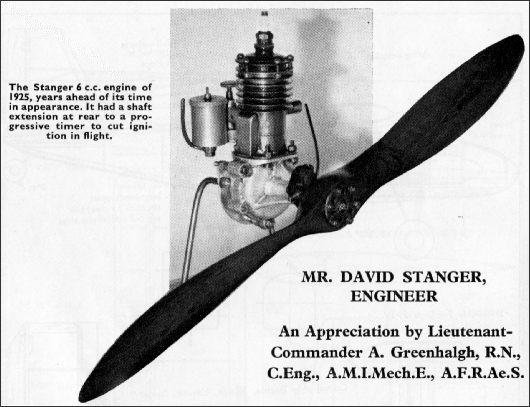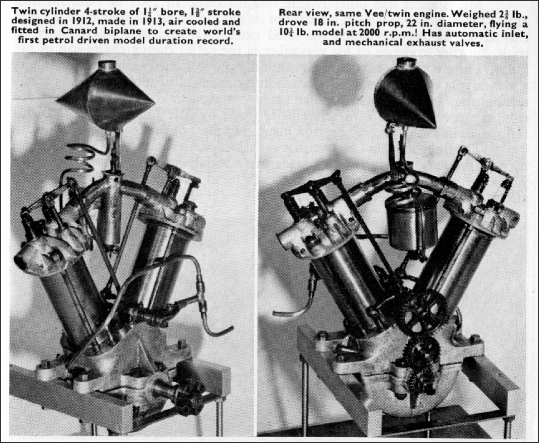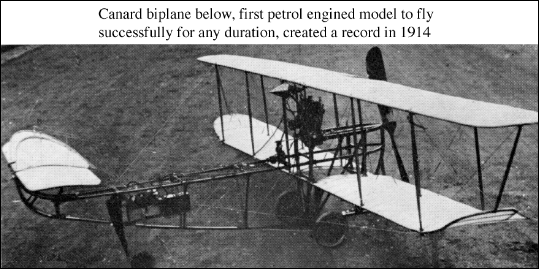 |
Here is a transcript of the article I found in the Sammy Miller Motorcycle Museum (Ron Moulton subsequently advised me that this article appeared in the 1969-70 Aeromodeller Annual. Thanks to his help, I was able to borrow a copy and re-scan the photographs )
The first petrol-driven model aircraft to fly successfully was built by David Stanger in 1908. It may be thought by some that Professor S. P. Langley was the first to achieve this distinction, but as his aircraft was a quarter-size version of the unsuccessful "Aerodrome" and was built under U.S. Government auspices, it cannot be considered to be a model in the accepted sense of the word. The first petrol engine to be built by Mr. Stanger was an air-cooled four-stroke, four-cylinder "V" type, of 1.25in. bore and 1.375in. stroke. The power developed was in the order of 1.25 h.p. at 1,300 r.p.m. when driving a 28-in. diameter propeller of 30-in. pitch. The engine weighed 5.5lb and had a cast aluminium crankcase and cast iron cylinders and pistons. It was designed in 1905 and built in 1906. When considering this engine, it is important to relate the date of design to other events aeronautical. It lies but eighteen months after the first manned aeroplane flew, and four years before Bleriot flew across the Channel. That Mr. Stanger designed and built an engine of such small dimensions which operated with a high degree of efficiency can only reflect on his great appreciation of I.C. engine principles and design at a time when knowledge was confined mainly to the few who had attempted to build full-sized engines. A biplane of 8ft. 2in. wingspan and 6ft. 10in. long was designed in 1907 and built in 1908. It was powered by the 1906 engine and weighed 21lb. This aircraft was the first true petrol-driven model to fly successfully. During the next two years, minor modifications were embodied as experience and knowledge of the model were gained. The result was a most reliable and stable aircraft. Demonstrations were made in the London area and Yorkshire.
The second engine to be built was an air-cooled, twin-cylinder, four-stroke "V" type of 1.25in. bore and 1.325" stroke. Lessons learnt from the first engine were considered in the design of the second, and the power-weight ratio was vastly improved. This engine was designed in 1912 and built in 1913. It was fitted in a "Canard" type biplane of 7ft. wingspan and drove a 22in. diameter propeller of 18in. pitch at 2000r.p.m. This aircraft weighed 10.75lb., of which the engine weight was 2.75lb. The flying speed was about 20m.p.h. On Sunday April 19th 1914, this aircraft established the first endurance record for petrol-driven models of 51sec o.o.s. at Hendon during the International Aero Exhibition. This record stood undefeated until Whit Monday 1932.
These first two engines had automatic inlet valves and mechanically operated exhaust valves. Mechanically driven oil pumps were fitted, and float type carburettors dealt with the fuel mixture. The third model aero-engine was built in about 1925 and was a three-cylinder four stroke, in-line, air-cooled type. This engine had mechanically operated inlet and exhaust valves. The high finish and lightness of this engine was remarkable for its day, and the float-type carburettor was one of the smallest ever made. The next engine was again a three cylinder in-line type, but was a two-stroke unit. The engine had a three-division cranckcase and was fitted with a twin-choke Carburettor supplied by a single float chamber. Up to this time, the spark plugs, ignition equipment and accumulator were all made by Mr. Stanger, no mean feat in itself. Several single cylinder air-cooled two-stroke petrol engines were built during the mid-1920s. Included in this series was one of about 1c.c. capacity which ran very well indeed. This engine was only surpassed in size and efficiency when the small commercially built diesel engine appeared in the 1950s. During this period several model biplanes and monoplanes were designed and built. The biplanes no doubt influenced other builders. Mr. Stanger had other engineering interests. In 1901 he built his own motor car, which was well in advance of its day. In about 1920 he built a 5h.p. Two-stroke motorcycle which was used extensively and most successfully on trials. Further evidence of his versatility is the set of dining chairs still in use today. There is also in existence a beautifully proportioned aluminium statuette which amply demonstrates his outstanding command of moulding and casting techniques. He constructed his own screw-cutting lathe by means of which his engines were built, his own micrometer (used by Mr. John Stanger until his retirement in 1958), protractor, iron plane, and most of the tools for his work. The foregoing has been written so that the achievements of David Stanger may be properly recognised and made more widely known. He was a pioneer whose creations were enormously successful, and were due entirely to his own efforts, working from basic principles. |
|||||
 |
||||||
 |
||||||
 |
||||||
 |
||||||
 |
||||||
For further articles about David Stanger's model aviation achievements, Click on the links below: |
||||||
Two views of remarkable Stanger 1908, 4-cycle, 4-stroke, 1.25h.p. at 1,300r.p.m. on 28in dia. prop! |
||||||
The above pictures will enlarge |
||||||
 |
 |
|||


